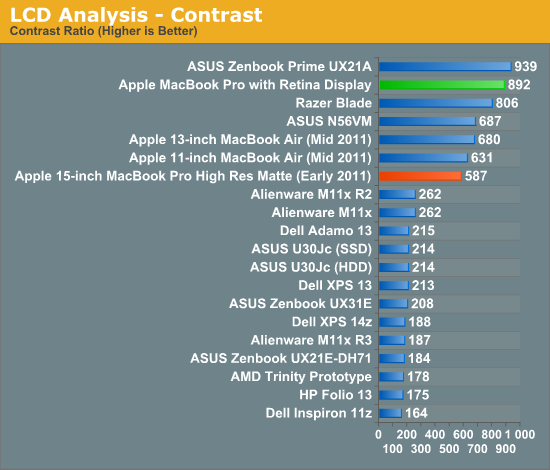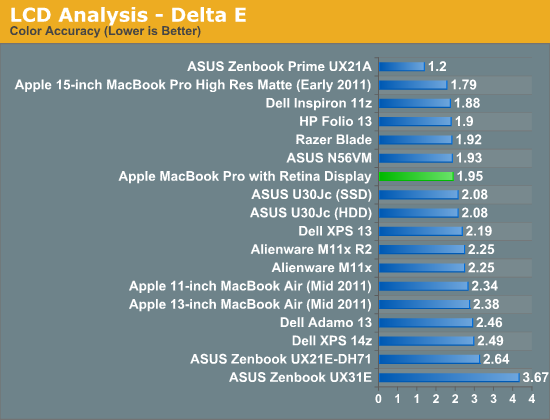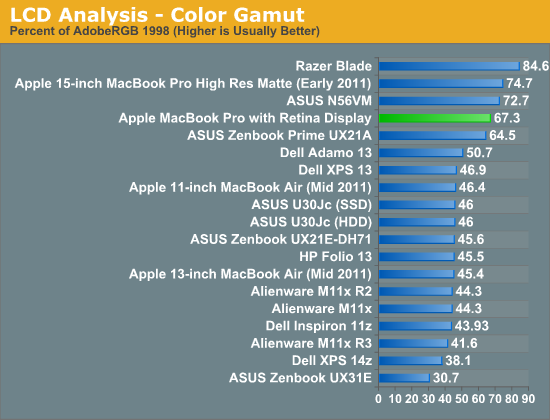The next-gen MacBook Pro with Retina Display Review
by Anand Lal Shimpi on June 23, 2012 4:14 AM EST- Posted in
- Mac
- Apple
- MacBook Pro
- Laptops
- Notebooks
The Retina Display in Numbers
I already published preliminary analysis of the Retina MacBook Pro’s display. In short brightness is down a bit, black levels are considerably improved and contrast as a result takes a huge step forward compared to previous models. My personal MacBook Pro used the anti-glare matte screen and the improvement in contrast ratio compared to that reference is over 50%.



Apple made no mention of impact to color accuracy or color gamut. It turns out that the omission was for good reason, the Retina Display offers no improvement along either vector. The numbers show a slight regression compared to last year’s panel but the difference is imperceivable.


Technically Apple’s use of the word Retina in reference to a display only refers to the inability for the human eye to resolve individual pixels at a specified distance (18-inches for the MacBook Pro). In practice however Apple has delivered tightly integrated IPS panels with wonderful performance characteristics as a part of the Retina brand. I do hope that for the years to come Apple does not compromise on these fronts.










471 Comments
View All Comments
Ohhmaagawd - Sunday, June 24, 2012 - link
It's a first step. There will be retina monitors in the future.Freakie - Monday, June 25, 2012 - link
Lolwut... Monitors that have great quality color are already high resolution... They were pushing major pixels before it was popular ;)vegemeister - Monday, July 2, 2012 - link
With the exception of the (discontinued and originally $10,000) IBM T221 and it's derivatives, no desktop monitor has resolution exceeding 2560x1600, and that resolution is only available in the 30" form factor.Solandri - Saturday, June 23, 2012 - link
I have the lower-end version of that particular laptop ("only" a 1600x900 screen, 2x64 GB SSD). I wish I'd opted for the 1080p screen. 1600p wide isn't really enough to put two apps side-by-side. I do that all the time on my 1920x1200 external monitor though.The screen is a glossy TN panel, but is pretty much the best TN panel I've used. My desktop monitor is IPS so I can see its limitations. But when I'm using the Z in public, the most frequently comment I get is how beautiful the screen is. Sony also does a stellar job with their anti-reflective coatings. it's a glossy screen, but I almost never see reflections (except in sunlight). Colors are a bit too saturated, and the custom color profile I made tones it down. Unfortunately none of the reviews on it tested its gamut. But from photo editing, it's got a wider gamut than most high-end laptop displays I've seen. And it's blindingly bright too - perfectly usable in direct sunlight at max brightness. I rarely run it over half brightness.
The quad-SSD was because the laptop came out before SATA3 SSDs were available (the SATA3 spec had only been finalized a few months prior). 2.5" SSDs were already hitting the limits of SATA2 (3 Gbps) and the only way to get around it was by putting multiple SSDs in a RAID 0 array. So that's what Sony did. The 4-SSD version benchmarks at 430-500 MB/s sequential read/write. Not too shabby in 2010 using 150 MB/s mSATA stick SSDs on SATA2.
Optical drives are more a matter of preference. I end up burning a lot of DVDs so it's definitely convenient. But if you don't do that or watch movies, then yeah I can see it being superfluous. As much as I'd like to see media being distributed on USB sticks, their cost of $1-$2 for 4GB vs. a few cents for a DVD means it's not happening yet. Do note that the Z tops out at 2.9 pounds. It's lighter than the first and second gen Macbook Air despite having a DVD/Bluray drive. That's the second most common comment I get - "It's so light!"
OCedHrt - Sunday, June 24, 2012 - link
The 1080p panel on the Z is IPS. And it's not glossy - you don't have a glass on your laptop. I believe this is more for weight reasons than anything else.maratus - Sunday, June 24, 2012 - link
No, it's not IPS.Solidstate89 - Saturday, June 23, 2012 - link
You have to be the most ignorant jackass I've ever seen. You've basically never even heard of that product until now yet that doesn't stop you from making baseless accusation after baseless accusation.Get the fuck over yourself. And Windows has always handled resolution scaling better than OS X, and it still does.
ananduser - Saturday, June 23, 2012 - link
In 2010 Sony offered a 13" MBP equivalent with matte 1080p TN panel(like all the other macbooks). It had a BluRay built besides a quad raid SSD option(that still exists). The current Z has the video card inside an external dock, it is as slim as the thinnest ultrabook with a full voltage CPU.OCedHrt - Sunday, June 24, 2012 - link
Sony offered it in 2008 :)OCedHrt - Sunday, June 24, 2012 - link
You are not applying the correct context.1080p is okay because windows has DPI scaling - though I agree with Anand that this doesn't work with apps that aren't written correctly. But the same applies to OS X. OS X handles it better because of vector based UI.
It is an IPS display with 92% color gamut that Anandtech called amazing. Don't even try to pretend it sucks: http://www.anandtech.com/show/5530/sony-vaio-z2-ev...
Blu-ray is not a default option, it is an extra configuration that you'd have to pay for. This isn't Apple were talking about - even Sony has typically more options than Apple.
Quad-SSDs. Yes. You need to remember that his happened back in 2008 when SSDs were not doing 500mb/sec. This was back when a quad SSD only netted you about 300mb/sec and before TRIM was prevalent.